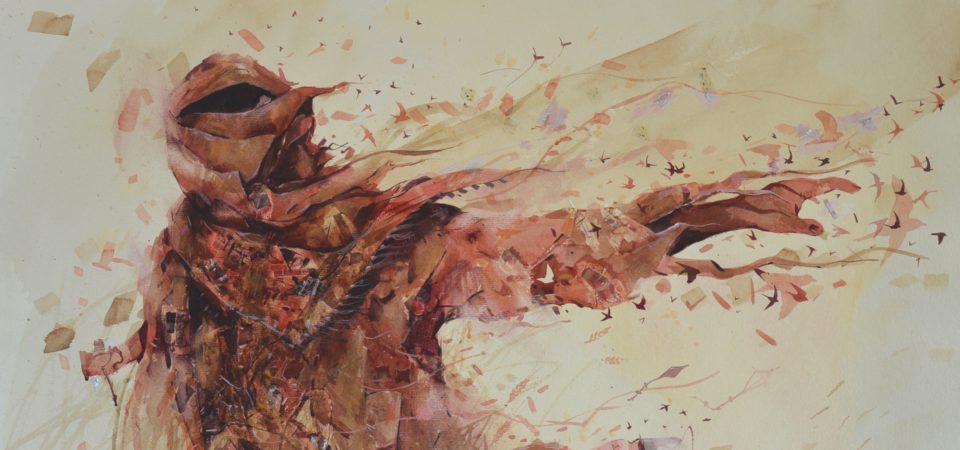Recently, the Society of Animal Artists held its 2021 Exhibition at the Roger Tory Peterson Institute, which marketed the exhibition under the mantra, “Art That Matters to The Planet.” The exhibition will travel to two other venues through May 2022.
One noteworthy work in the exhibit is “The Day the Bees Died” by Scottish artist and signature member of the society, Derek Robertson, who was given an Award of Excellence for the work by the museum. Robertson’s work derives from direct observation and this annotated, watercolor painting of dead bumblebees, wildflowers and an agricultural sprayer is no exception.
“I was painting in a friend’s wild meadow garden when a sprayer drove through the adjoining field. I packed up and went inside to avoid the drifting spray. The next day my friend called and told me her garden was full of dead bees, so I went back there and found dozens and dozens of their corpses scattered along the pathways.”
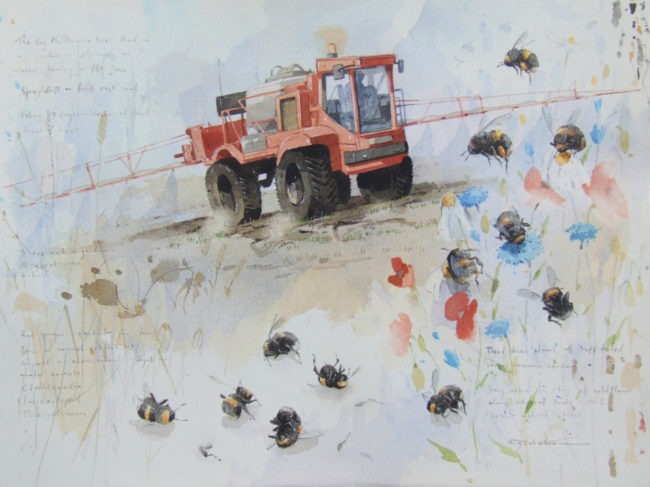
Robertson’s artwork reflects on our relationship with the natural world and his artistic practice has been informed by over 30 years of exploring and sketching in the Scottish landscape to understand the wildlife that lives there and the ecology that supports it. As well as being fascinated by wildlife as an artist, he is an enthusiastic amateur naturalist and licensed bird-bander who has partnered studies with universities and with research and conservation organizations. Therefore, he has contributed to and written, research papers published in academic journals and books on bird behavior and migration. Today, Derek’s creative practice involves carefully developed and researched projects that build large, narrative collections of his paintings, assemblages, and installations.
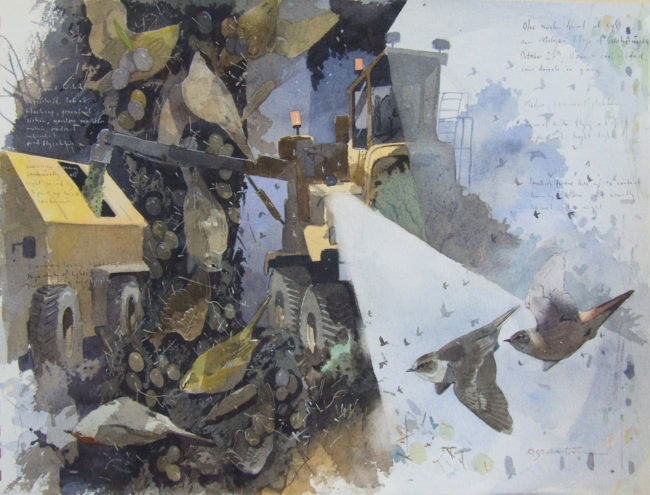
The Testaments of Loss
His painting of the dead bees is from his long-term project “Testaments of Loss”. Loss of biodiversity, habitats, and the consequences of trophic cascades are considered as serious an environmental threat as climate change (to which each is intricately linked). In this ongoing project, Derek is creating a series of direct paintings and sketches documenting small-scale incidents of environmental loss. These will be collected to form a large wall of 100 or more paintings that give a sense of scale and range beyond their small and immediate observations. He had begun these using the same methods he uses for other field sketchings. They are sketchbook pages- direct observations annotated with notes in the field. They are framed as objects, with ragged edges of spiral bindings.
“I started by going to specific spots to document events: hedges and trees around building developments netted off to exclude birds; wildflower meadows killed off by herbicides, bees killed by pesticides, birds of prey shot illegally as vermin. I then realized I have 30 years of archival material in my sketchbooks of incidents I have recorded in the field covering a huge range of subject matter. Through lockdown I have been developing these into finished paintings and, as circumstances allow, I am going to do further research trips to compile more material.”
Derek is also exploring how this project could be developed as a sound/moving image installation and to this end, he has been collaborating with musicians, computer games designers, and the poet Kathleen Jamie who is the Scots Makar (the National Poet for Scotland, appointed by the Scottish Government) and using a small project grant from Creative Scotland (the national arts organization) to conduct a series of “creative laboratories” between scientists and the collaborators.
Derek is also exploring how this project could be developed as a sound/moving image installation and to this end, he has been collaborating with musicians, computer games designers, and the poet Kathleen Jamie who is the Scots Makar (the National Poet for Scotland, appointed by the Scottish Government) and using a small project grant from Creative Scotland (the national arts organization) to conduct a series of “creative laboratories” between scientists and the collaborators.
Migrations
The Testaments of Loss project follows on from his powerful collection of work entitled “Migrations” which brought together topics of climate change and refugee crises using birds as a metaphor for people and also in their role as environmental indicators. For decades Derek has been studying and depicting the migration of birds and has followed them from Africa to the Arctic through their migration routes across the Mediterranean and their home ranges in Europe. Birds are used as warning indicators of environmental change – the changes we now observe in their migration patterns reflect significant climate and habitat changes
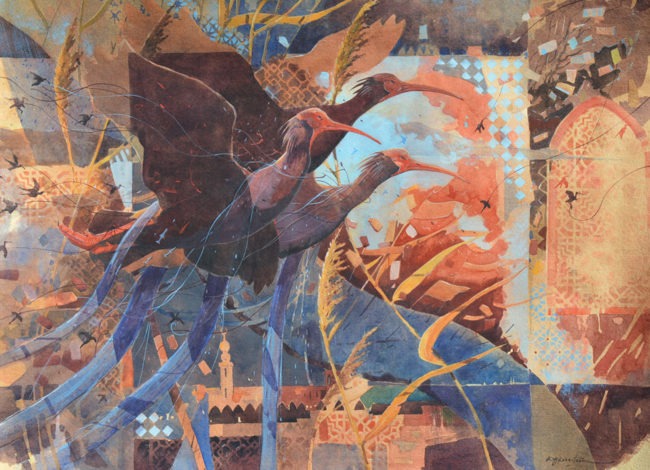
Our responses to the issues of environmental change and the refugee crisis in the coming few decades will define who we are, the societies we create, and how we live. These issues are extremely complex but are linked. Studies by a number of research institutions have indicated causal links between climate change, civil war, and refugee disasters.
Derek’s observations of wildlife and his choice of nature as a subject of study are influenced by the direct and elemental character of these creatures. It focuses on questions of what our place is in the environment and what it means to be alive. Grievously, the experience of refugees and migrants is often reduced to the same brutal and immediate question of survival. “I was watching the refugee crisis unfold on television when I saw a news reporter on a Mediterranean beach talking as refugees arrived on dangerously flimsy boats. People were crying and in obvious distress. I suddenly realized that I recognized that beach. It was on an island where I had gone to study and sketch migrating birds- the constraints of geography meant that the flight lines of birds have become the routes of flight for refugees.”

The project was entirely self-funded and directed by Derek in response to that initial catalyst. It entailed Derek spending over a year creating new work and visiting refugee camps and transit points – from communities settled in his home city in Scotland, and traveling through the UK and Europe as far as the borders of Syria and Iraq. In his travels, he often stayed with refugee families and volunteered in camps- packing boxes or even teaching art classes to children. These paintings overlay depictions of refugees and migrants with studies of migrating birds. The paintings blend stories, songs, tradition, and acute personal observation. The result has been a series of exhibitions, presentations, and articles spanning art festivals, birdwatching conferences, and academic refugee studies, and an exhibition and series of talks at the Scottish Parliament.
From The Bird’s Mouth
Derek’s most recent project brings together wildlife, language, poetry, and artwork to describe how human agency is changing our environment. Derek describes it in these words, “A language holds its own traditions and treasures. In Scots Gaelic (the oldest, native language in Scotland), the word “dualchas” encompasses the intimate bonds that exist between the natural world, the land, and its people – connecting through language, tradition, and culture from generation to generation. The Gaelic names of the animals and plants that inhabit that landscape are a part of that tradition and reflect aspects of these relationships.” In recent times, a number of animals and plants have appeared in Scotland as our climate changes, or otherwise helped there by human activity, and some are so new to Scotland they don’t yet have a Gaelic name. From the Bird’s Mouth, Bho Bheul an Eòin, is naming the new. Through a process of research and consultation, with advice from scientists, researchers, and Gaelic writers, the project has given Gaelic names to these colonizers and tells their story in a book, website, and traveling exhibition. The collected artwork has been shown at several venues in Scotland including the Royal National Mod (the annual event promoting Gaelic language and culture).
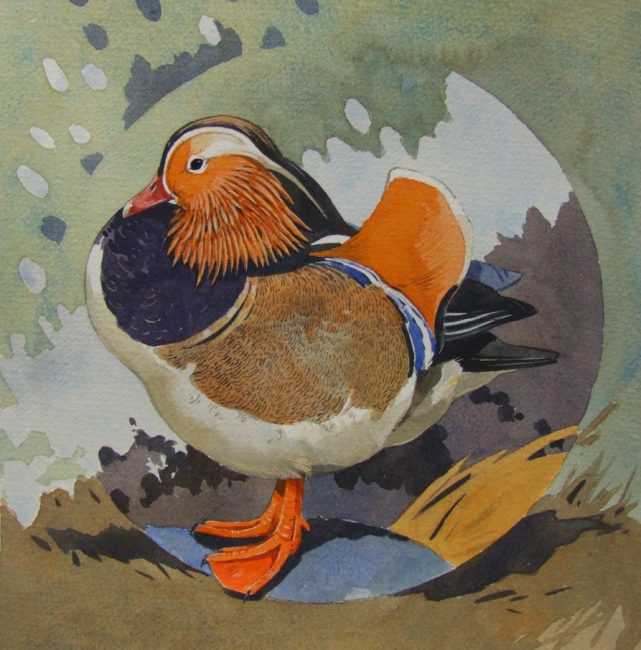
The poet Rody Gorman is a translator for the book in which he has created a series of new poems using the new names for each species and placing them in the Scottish landscape and poetic tradition. He was named this year’s Bàrd a’ Chomuinn (official poet for the Royal National Mod). The collection has gone on to be displayed at the United Nations Climate Change Conference COP26 in Glasgow at the invitation of Scottish Government agencies.
Derek brought together this partnership project which has been supported by NatureScot (the Scottish Government’s nature conservation body) and Bòrd na Gàidhlig (the government language body for Gaelic).
The project advisors are from a wide variety of agencies and the names created will be submitted to their database archives. The project will allow Scots Gaelic speakers and learners to give voice to the new nature around them and maintain Gaelic’s rich, cultural link with the changing ecology of the landscape in which it is embedded.
Development
The nature of these long-term projects is that they continue to develop further, even when the planned books and exhibitions have been completed. Each of the projects above has plans for further collaborations and tangents including new books, new naming projects, and further research trips to investigate new ideas. “What I like about these projects is that they draw me into detailed research of ideas that are completely new to me and that is the same for the opportunities for collaboration. The process of working together creatively will often bring about something really novel and exciting that each of us wouldn’t have come up with on our own. As an artist, that is incredibly inspiring”.
 Derek Robertson has been a professional artist since graduating from Duncan of Jordanstone Art College in 1989. Best known for his paintings of wildlife, he has also illustrated and written numerous books and featured in press, radio and appeared on television as both a writer and presenter. He exhibits around the world and his paintings are held in collections in more than 50 countries including those of the collection of the British Royal Family, The Tate Gallery, The Scotland Office in London, and the Leigh Yawkey Woodson Museum. He has illustrated and written many books and his work has won awards and commendations in the UK, Europe, and the USA.
Derek Robertson has been a professional artist since graduating from Duncan of Jordanstone Art College in 1989. Best known for his paintings of wildlife, he has also illustrated and written numerous books and featured in press, radio and appeared on television as both a writer and presenter. He exhibits around the world and his paintings are held in collections in more than 50 countries including those of the collection of the British Royal Family, The Tate Gallery, The Scotland Office in London, and the Leigh Yawkey Woodson Museum. He has illustrated and written many books and his work has won awards and commendations in the UK, Europe, and the USA.
You can find out more about Project in detail at the web pages below which include links to interviews on Youtube.
www.creativepastures/testaments
www.creativepastures/migrations
www.fromthebirdsmouth.com
The Society of Animal Artists Tour, directed by David J. Wagner, Ph.D., will include the following venues:
The Hiram Blauvelt Art Museum
November 20, 2021 – January 16, 2022
Oradell, NJ
The Sternberg Museum of Natural History
Fort Hays State University
February 5 – May 5, 2022
Hays, KS
Exhibition updates are available at: https://www.societyofanimalartists.com/exhibitions-of-the-society-of-animal-artists/61st-exhibition-of-the-society-of-animal-artists/
The Sternberg Museum of Natural History
Fort Hays State University
February 5 – May 5, 2022
Hays, KS
The MAHB Blog is a venture of the Millennium Alliance for Humanity and the Biosphere. Questions should be directed to joan@mahbonline.org

